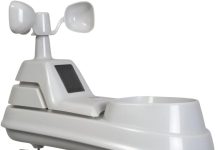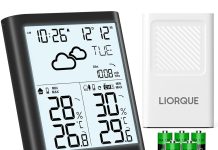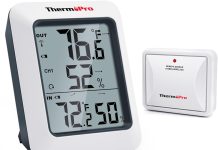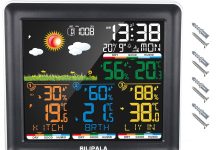Weather is essential in agriculture as it influences crop growth, pest and disease outbreaks, and water management decisions.
Farmers must know the weather conditions to make informed decisions about their crops. That’s where weather stations come in handy.
Weather stations are devices that collect and transmit weather data.
They can help farmers make better irrigation decisions, protect crops from frost damage, and observe wind conditions before spraying.
Farmers can optimize their crop yields and minimize losses due to weather-related risks with accurate and reliable weather data.
Weather stations can provide valuable insights into the local weather conditions at any scale.
A single station is likely sufficient for small farms, while more extensive operations may require multiple stations to cover a wider area.
This article will explore how weather stations can help farmers manage their crops more efficiently and increase profitability.
Understanding Weather Stations
As farmers, we understand the importance of having accurate and up-to-date weather information to make informed decisions about our crops. This is where weather stations come in.
A weather station is a device that measures various weather conditions such as temperature, humidity, rainfall, wind speed, and wind direction. It can provide us with real-time data, historical data, and weather forecasts to help us plan and manage our farms more efficiently.
Weather stations come in different shapes and sizes, from personal to professional-grade stations used by meteorologists. One of the most popular brands of weather stations is Davis Instruments, and their Vantage Pro2 weather station is a favorite among farmers.
It provides accurate and reliable weather information, including up-to-the-minute data and historical records.
Ensuring its accuracy is essential to get the most out of a weather station. We can do this by regularly calibrating the sensors and ensuring the station is installed in an appropriate location away from any obstructions that may affect its readings.
Additionally, we can use the software provided by the manufacturer to monitor the station’s data and detect any issues that may arise.
One of the main benefits of using a weather station is the ability to make informed decisions based on real-time weather conditions. For example, we can use the data to determine when to irrigate our crops or apply fertilizers.
We can also use the information to protect our crops from frost damage and observe wind conditions before spraying.
Weather stations are a valuable tool for farmers, providing accurate and reliable weather information to help us manage our farms more efficiently.
By understanding how weather stations work and ensuring their accuracy, we can make informed decisions based on real-time data and historical records.
Ambient Weather WS-5000 Ultrasonic Smart Weather Station
$359.99 in stock
1 used from $420.95
Davis Instruments Vantage Vue with WeatherLink Console -Metric
Importance of Weather Stations for Farmers
Weather stations are an essential tool for farmers as they provide accurate and up-to-date information about the weather conditions in their area. This information enables us to make informed decisions about crops, irrigation, and other farming practices.
Having access to real-time weather data allows us to be better prepared for any changes in the weather. We can adjust our farming practices accordingly, saving us time and money in the long run. For example, if we know that a frost is coming, we can take measures to protect our crops from damage.
Weather stations also help us to make more efficient use of our resources. Knowing when it will rain, we can adjust our irrigation schedules and avoid wasting water. This not only saves us money on our water bills but also helps to conserve this precious resource.
In addition to making more informed decisions, weather stations can help us succeed more in agriculture. We can plan our planting and harvesting schedules more effectively by accessing accurate weather data. This can help us to maximize our yields and increase our profits.
Overall, weather stations are an invaluable tool for farmers. They allow us to make informed decisions, be better prepared for changes in the weather, and increase our efficiency and success in the agriculture industry.
Davis Instruments Vantage Vue Wireless Sensor Suite with WeatherLink Console
Davis Instruments 6152 Vantage Pro2 Wireless Weather Station with Standard Radiation Shield and LCD Display Console
Weather Parameters and Their Significance
As farmers, we understand the importance of weather parameters in managing our farms efficiently.
Weather stations provide accurate and timely information about various weather parameters, which helps us make informed decisions.
This section will discuss some of the most essential weather parameters and their significance.
Temperature and Humidity
Temperature and humidity are crucial weather parameters that affect crop growth and development.
High temperatures can cause wilting and stress in plants, while low temperatures can slow growth. Humidity affects the plant’s ability to transpire, essential for nutrient uptake and photosynthesis.
Rainfall and Irrigation
Rainfall and irrigation are crucial for crop growth and development. Too much or too little water can cause stress and affect crop yield.
Weather stations help us monitor rainfall and soil moisture levels, which helps us make informed irrigation decisions.
Wind Speed and Direction
Wind speed and direction affect crop growth and development. Strong winds can damage crops, while light winds are necessary for pollination.
Weather stations help us monitor wind conditions, which helps us make informed decisions about spraying and other field operations.
Soil Moisture and Temperature
Soil moisture and temperature affect nutrient uptake and plant growth. Weather stations help us monitor soil moisture and temperature, which helps us make informed decisions about irrigation and fertilization.
Light and Solar Radiation
Light and solar radiation are essential for photosynthesis and plant growth. Weather stations help us monitor light and solar radiation, which helps us make informed decisions about crop rotation and planting.
Pressure and UV Index
Pressure and UV index affect crop growth and development. High pressure can cause plant stress, while low pressure can cause wilting. UV index affects plant growth and development; high levels can cause sunburn and crop damage. Weather stations help us monitor pressure and UV index, which helps us make informed decisions about field operations.
In conclusion, weather stations provide accurate and timely information about various weather parameters, which helps us make informed decisions about field operations.
We can manage our farms efficiently and improve crop yield by monitoring weather parameters.
Ambient Weather WS-5000 Ultrasonic Smart Weather Station
$359.99 in stock
1 used from $420.95
Davis Instruments Vantage Vue with WeatherLink Console -Metric
Weather Stations and Crop Health
Weather stations are crucial in monitoring and predicting weather conditions affecting crop health.
By providing real-time data on temperature, humidity, wind speed, and precipitation, farmers can make informed decisions about irrigation, fertilization, and pest management.
One of the most significant benefits of weather stations is their ability to detect severe weather conditions that can damage crops.
For instance, heavy rainfall can lead to soil erosion, nutrient leaching, and root damage. On the other hand, drought can cause stunted growth, reduced yield, and crop failure.
With weather station data, farmers can anticipate these conditions and take preventive measures such as adjusting irrigation schedules or planting drought-resistant crops.
Weather stations can also help farmers identify potential disease outbreaks. Some fungi and diseases thrive in moist environments, and high leaf wetness can promote their growth.
By using leaf moisture sensors, farmers can monitor the moisture content of their crops and adjust their irrigation practices accordingly. This can help prevent the spread of diseases and reduce the need for fungicides.
In addition to monitoring weather conditions, weather stations can provide valuable environmental data. For example, they can measure soil temperature and moisture, which can help farmers determine the best time to plant seeds.
They can also detect the presence of pests and insects, allowing farmers to take appropriate action before the infestation spreads.
Weather stations are valuable for farmers to maintain crop health and maximize production. Providing accurate and timely data on weather conditions can help farmers make informed decisions, ultimately leading to higher yields and better-quality crops.
Weather Stations and Farming Decisions
Many decisions must be made to ensure the best possible crop outcomes when farming. Weather plays a crucial role in these decisions, and having access to accurate and up-to-date weather data is essential.
This is where weather stations come in.
With an agricultural weather station, we can gather real-time data on various weather conditions, including temperature, humidity, wind speed and direction, rainfall, and soil moisture. This information can help us make informed decisions about when to irrigate, fertilize, and apply manure and when to plant and harvest crops.
One of the most significant benefits of having a weather station on the farm is that it allows us to monitor soil moisture levels. Soil moisture sensors can be placed in the field to provide up-to-the-minute information on the soil’s water amount. This information is crucial for irrigation decisions, as over- or under-watering can lead to crop failure and financial losses.
Another important use of weather station data is in predicting and managing frost damage. By monitoring weather patterns and analyzing historical data, we can decide when to apply frost protection measures and purchase crop insurance.
In addition to providing us with real-time data, weather stations also allow us to track changes in weather patterns over time. This information can be used to identify trends and make investment decisions based on climate change projections.
Overall, having access to hyperlocal weather data through an agricultural weather station can help us make more informed decisions about managing our crops, controlling our resources, and optimizing our productivity.
Davis Instruments Vantage Vue Wireless Sensor Suite with WeatherLink Console
Davis Instruments 6152 Vantage Pro2 Wireless Weather Station with Standard Radiation Shield and LCD Display Console
Final Thoughts
In conclusion, weather stations are essential for farmers to make informed decisions about their crops. By providing accurate and real-time weather data, farmers can optimize their irrigation schedules, protect their crops from frost damage, and make better decisions about when to work in the field.
The data collected by weather stations can also help farmers manage their resources more efficiently. For instance, knowing the exact amount of rainfall can help farmers save water resources, especially in dry rural areas.
Furthermore, weather stations can provide invaluable insight and knowledge to farmers. By monitoring weather patterns and trends, farmers can better understand the environmental conditions affecting their crops and make informed decisions about planting and harvesting times.
Weather stations are indispensable for farmers looking to maximize their crop yields and minimize their environmental impact. With the help of weather stations, we can make better decisions about our crops and ensure a more sustainable agricultural future.
Frequently Asked Questions
What is the benefit of a weather station?
Weather stations provide farmers with real-time weather data, which can help them make informed decisions about their crops.
Farmers can adjust their planting schedules, irrigation systems, and pest control methods to optimize crop growth and yield by monitoring temperature, humidity, rainfall, wind speed, and soil moisture.
How does knowing the weather help farmers?
Knowing the weather helps farmers plan their work and make informed crop decisions. For example, if farmers know that a heatwave is coming, they can prepare their irrigation systems to ensure their crops don’t dry out.
Similarly, if farmers know that a storm is coming, they can take steps to protect their crops from wind and hail damage.
How does weather affect farmers?
Weather can have a significant impact on farmers’ livelihoods. Extreme weather events like droughts, floods, and hurricanes can damage crops, destroy infrastructure, and disrupt supply chains. Even minor weather variations like temperature and humidity can affect crop growth and yield.
How can farmers use weather station equipment?
Farmers can use weather station equipment to monitor temperature, humidity, rainfall, wind speed, and soil moisture. This data can help them make informed decisions about their crops, such as when to plant, harvest, rinse, and apply pesticides and fertilizers.
What are some of the best weather stations for agriculture?
Many weather stations are available on the market, each with features and capabilities. Some of the best weather stations for agriculture include the Davis Vantage Pro2, the Ambient Weather WS-2902C, and the AcuRite 01036M.
How can farmers protect their crops from the weather?
Farmers can protect their crops from the weather by taking various measures, such as planting windbreaks, using irrigation systems, applying pesticides and fertilizers, and building protective structures like greenhouses and hoop houses.
Farmers can also proactively protect their crops from extreme weather events by using weather station equipment to monitor weather conditions.
Davis Instruments Vantage Vue Wireless Sensor Suite with WeatherLink Console
Ambient Weather WS-5000 Ultrasonic Smart Weather Station
$359.99 in stock
1 used from $420.95











































